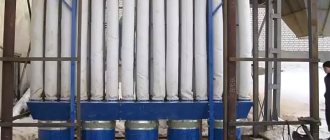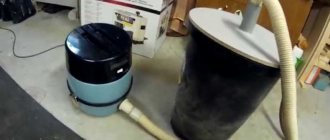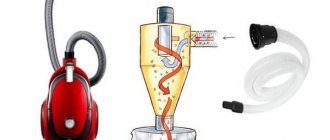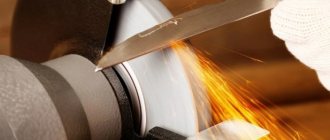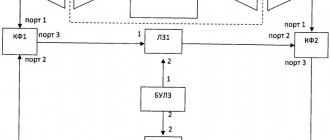The manufacturer of gas purification, smoke purification and dust collection equipment "PZGO" welcomes Visitors and Clients and offers for in-depth consideration and analysis the types, design, principles of operation, purpose, characteristics and technological features of this type of device such as an industrial cyclone for air purification (cyclone filter dust collector).
We will professionally calculate, design and - on our own production line - manufacture an effective, compact, reliable, durable and affordable industrial cyclone filter. Our dust and gas purifiers serve reliably at more than 200 industrial sites in Russia, the CIS, Europe and Asia.
Ask us a question or request professional equipment advice
PAGE NAVIGATION
- origin of name
- Definition, structure and design of a cyclone filter
- Operating principle
- Purpose and scope of application
- Efficiency
- Dust bins, sludge unloading
- Types and types of cyclones
- Countercurrent cyclones
- Bag cyclones
- Hose cyclones
- Wet irrigated cyclones
- Multicyclones
- Medium recycling
- Reverse Taper Models
- Horizontal direct-flow, CPU
- For vacuum cleaners
- Abrasive wear of the working chamber
- Static electricity problem
- Processing of explosive and fire hazardous environments
- Advantages and disadvantages of cyclone filters
- Specifications
- Order, production and implementation of cyclone filters
Origin of the name of the cyclone filter and correlation with the climate phenomenon of the same name
A household or industrial cyclone - as a system or apparatus for purifying air from solid particles - takes its name from a weather phenomenon.
In climatology, a cyclone (from ancient Greek Kuklos - circle) is a large-scale atmospheric vortex formation with pressure decreasing towards the center (the so-called “eye of the cyclone”). The vortices can have a diameter of up to thousands of kilometers and are observed everywhere (except for the equatorial zone), arising as a result of the twisting of air masses when warm and cold atmospheric fronts collide.
Animation of the operation of a rotary-vortex dust precipitator
The cyclone air filter - by analogy - generates a radially swirling dust-air environment (swirling the air inside the working chamber), therefore cyclone dust collectors are also called vortex, rotational, gravitational, centrifugal or inertial precipitators.
The cyclone separator (under the original name “cyclonic separator”) was invented by the American John M. Finch, who in 1885 patented it as a dust collector for his industrial. By 1900, radial-inertial dust collection units were already widely used in many factories and mills in the United States, and then throughout the world.
Definition, structure and design of a cyclone filter
A cyclone is a composite module or an independent device for inertial-centrifugal purification of air or other gas mixtures from dry, non-coalescing (except talc and ash), solid particles of coarse and medium dispersion ( > 10-20 µm ). It is used both as a separate dust collector and as the first stage of coarse cleaning in fine gas filtration systems and installations.
Structurally, a “traditional” counterflow cyclone is a vertical column of circular cross-section, the bottom of which, as a rule, tapers conically (cylindrical-conical shape); in the lower part there is usually a dust outlet pipe, through which the collected solid particles are discharged into the dust collection hopper.
The main technological units and related components of the cyclone are:
- The body itself, fixed to the support frame;
- Inlet pipe with a cover (volute or collector), outlet pipe, outlet pipe / discharge of solid sediment into the hopper;
- Dust collector / ash collector / sawdust collector;
- Pressure fan/exhaust fan;
- Service structures – stairs, platforms, technological, inspection hatches (for large models);
- Recirculation pumps / smoke exhausters (optional for battery versions);
- Replaceable abrasion-resistant bushings or lining/lining of the working chamber and critical components (optional);
- Pre-cooling/flow dewatering chamber (optional);
- Optional - gate valves (plate-shaped dampers on the inlet or outlet pipes);
- Intake ducts/umbrellas (within the framework of using a cyclone for aspiration, ventilation), air ducts, electrical cable products, passports, instructions.
Basic operation scheme
[edit]Efficiency
The degree of cleaning in a cyclone strongly depends on the dispersed composition of dust particles in the gas supplied for cleaning (the larger the particle size, the more effective the cleaning). For common cyclones of the CN type, the degree of purification can reach:
| for particles with a nominal diameter of 20 microns | 99,5% |
| for particles with a nominal diameter of 10 microns | 95% |
| for particles with a nominal diameter of 5 microns | 83% |
As the diameter of the cyclone decreases, the degree of purification increases, but the metal consumption and cleaning costs increase. For large volumes of gas and high purification requirements, the gas flow is passed in parallel through several small-diameter cyclones (100-300 mm). This design is called a multicyclone or battery cyclone. It is also possible to use an Electrostatic filter, which, on the contrary, is effective specifically for small particles.
Detailed working principle of cyclone
The principle of operation of the cyclone filter is to swirl the contaminated flow inside a cylindrical-conical cavity; The operation of the device can be examined in detail through the following points:
- The flow is supplied to the device tangentially (tangentially) to the axis of the column or cylindrical filter block, through the upper or lower part of the unit;
- Tangential input of the medium leads to radial twisting, turbulence of the flow contaminated with particles (dust, sawdust, shavings) inside the working chamber;
- The rotational-translational motion of the flow provides a centrifugal force, which inevitably carries solid particles to the inner walls of the chamber;
- Colliding with the inner walls of the cyclone, the particles lose speed, and in the near-wall layer the gravitational force and the force of the so-called. the secondary flow begins to prevail over the kinetic energy of the particles, as a result of which dust or ash falls down the walls - into the dust or ash bunker;
- The purified air at the bottom of the column changes the direction of movement to vertical (the so-called counterflow), rises up through the central part of the column and is discharged from the upper outlet pipe directly into the atmosphere, the production workshop, or is sent through flues to the next stage of finer air purification, for example, in bag, absorption or electrostatic filter;
- The collected solid residue can be returned to the production cycle or sent for processing/disposal.
3D model of a cyclone
Household cyclone modules, for example, in modern home vacuum cleaners, operate on a similar principle, although they can be positioned horizontally or at an angle (see “direct-flow cyclones” below). This orientation does not lead to a significant decrease in efficiency - the inertial spin of dust is sufficient for its removal (through a special slot or group of holes) into the dust collector connected to the cyclone.
Manufacturing of cyclone elements
On specialized Internet forums you can find drawings of all components of the unit, which are available for making them yourself. Using improvised means, a household (or better yet, an industrial) vacuum cleaner is often remade. Additionally required:
- a set of hoses made of translucent corrugated material (this will facilitate visual control of dust particles settled inside). For chip extraction, rubber hoses are more practical;
- a soundproofing box that will perform two functions - it will reduce the noise level in the workshop, and provide additional protection for all machines and power tools located there from static electricity periodically accumulated by dust. For this purpose, you can make the box yourself from plywood, and decorate the inside with any type of sound insulator;
- air ducts for purified air: assembled with your own hands from a thin aluminum sheet and connected to each other with folds;
- waste collection container - can be made from an ordinary construction bucket with a capacity of 20 liters or more, which is sealed with the body of a homemade cyclone using a corrugated hose;
- filter (you can use a filter from trucks), which is installed on the outlet pipe.
A vacuum cleaner converted with your own hands for the needs of dust removal is checked: first at idle, passing normal air through the system, and then with the vacuum cleaner connected to a working machine.
Purpose and scope of application of cyclones
The main purpose of this class of equipment is to capture dry solid suspended particles of medium and coarse dispersion, which dictates the applicability of the installations as dust collectors and ash purifiers.
Let us display in the table the main areas of application of cyclone filter devices.
| Field of application/industry | Type of captured particles (suspended particles) |
| General industrial use | Coarse dust, sawdust, dry shavings of a non-cementing nature, aspiration of dusty places, machines, chambers, cabinets, boxes, smoke emission generators, conveyors, elevators, etc. |
| Woodworking, carpentry, workshops, furniture production | Wood dust and shavings, veneer scrap, chips, bark, sawdust collection |
| Metalworking, metalworking, welding | Metal dust and filings after cutting, drilling, sawing, milling, welding, rough polishing, metalwork, sandblasting workpieces |
| Collection of solid smoke (soot air, soot and gas) emissions from power plants / boiler houses (liquid and solid fuel boilers), waste incinerators, cremators, furnaces, furnaces of smelting units | Ash, soot, soot, ash after burning organic fuel, solid waste, solid waste, often a cyclone is used as the first stage of a dust and gas treatment plant |
| Construction, production of building mixtures | Multi-component construction dust, concrete dust, stone (mineral, including talc), brick chips, scrap, dry construction mixtures, mechanical processing of building blocks and surfaces with a wall chaser, jackhammer, hammer drill, and other tools |
| Mechanical processing of polymers and rubbers | Polymer, rubber crumbs, coarse dust, shavings, trimmings |
| Flour milling, grain, food industry, agricultural complex, grain crushers, shredders | Flour, coarse flour, husks, husks, petioles, hay, straw, bran, fluff, impurities, plant fibers (tea, tobacco, coffee, cotton, etc.). |
| Powder painting | Solid aerosol of paint, pigments, dyes |
Two-stage dust and gas purification system based on a scrubber and a rotary dust collector (as the first filtration link). Made in "PZGO"
Efficiency of cyclones depending on dispersion
Cyclonic dust and ash collectors show unequal efficiency in capturing particles of different dispersity. Efficiency - high for large particles (sawdust and shavings) - decreases with decreasing size of the captured elements. Let's display the efficiency in the table.
| Particle dispersion | Theoretical cleaning efficiency |
| More than 20 µm | ≈ 99% |
| More than 10 µm | ≈ 95% |
| More than 5 µm | ≈ 80% |
An increase in the diameter of the vortex dust precipitator column also leads to a slight weakening of the filtration efficiency of dust-air suspension. High efficiency is shown by columns with a diameter-to-height ratio of 1.6, which corresponds to the “golden ratio” rule.
Dust bins, sludge unloading
The hopper is an important structural part of the cyclone installation. The dust collector (sawdust collector) can have, depending on the dimensions and performance of the device, a wide range of volumes (from several dm3 to several tens of m3).
Dust unloading can be done manually (for small models) or automatically - using a screw or other conveyor (for large-sized cyclones).
The shape of the hopper can be cylindrical, cubic, pyramidal, truncated-conical, in the form of a parallelepiped, with a trapezoidal narrowing in the lower part (to accommodate the worm). In small versions of cyclone dust collectors, it is common practice to design bins in the form of drawers on skids.
Types and types of cyclone filters
Let's consider the variety of vortex inertial dust collectors and outline their main features and differences.
Countercurrent cyclones, abbreviation “C”
This term hides the most common, “classical” type of gravity-vortex dust cleaners, and the name is due to the fact that the medium in the dust collector, having reached a certain theoretical point, turns 180 degrees and rises up through the center of the column - against the flow of incoming air or gas.
Counterflow cyclone smoke purifier (in the foreground), made at PZGO
Looking ahead, it should be noted that countercurrent varieties are divided into many subtypes, which have their own nuances, but - in general - do not deviate far from the fundamental principle of operation of a countercurrent cyclone.
Bag cyclones
In some models, the cyclone column is supplemented with outlets to bags mounted on the supporting frame of the unit.
Bag version
Since centrifugal dust collectors show maximum efficiency only in relation to coarse and medium-dispersed particles, some manufacturers supplement the precipitators with a complementary bag system for collecting fine dust, which - under normal conditions - freely bypasses the column and is discharged through the outlet valve.
In such designs of dust collectors, small particles are directed through special air ducts into dust collection bags, and the flow of coarse and medium-dispersed dust enters the cyclone filter, where it is filtered on a vortex basis.
Hose cyclones
Some manufacturers of industrial cyclones are experimenting with combining bag and cyclone filters in a single housing.
Combined version (scheme)
In fact, such air purifying devices are hose blocks mounted on a plate and placed inside a rotating cyclone.
Such dust cleaning units combine the principles characteristic of both bag and vortex dust precipitators - medium and large particles are retained on the centrifugal-inertial principle, and the remaining microdispersed dust is filtered in microporous non-woven bags, just as it happens in “true” hose dust collectors.
Comment by “PZGO”: the use of the above models is justified only in specific conditions that exactly correspond to the stereometric, technological and economic expectations of the Customer. In most practical applications, two-stage filter systems based on a coarse cyclone and a full-fledged, full-size bag or even absorption filter will be much more effective.
Wet cyclones (hollow film scrubbers with flowing film)
Outstanding in its differences from the other gravity dust collectors discussed on this page is the wet cyclone, also called a hollow irrigated film scrubber.
Schematic diagram of the operation of a hollow scrubber
Structurally, the wet cyclone filter includes, in addition to everything, an irrigation unit (nozzle block) and is a “modernized” version of the dry cyclone.
The fundamental differences can be described as follows:
- In addition to the turbulence of the medium and the inertial rejection of particles on the chamber walls, the hollow scrubber generates a liquid micro-fog inside the working chamber, in which undesirable impurities are sorption;
- Spraying water (or absorbent) creates a flowing liquid film on the inner walls of the chamber, which continuously carries the captured impurities down into the sludge collector.
Important advantages of wet filters are:
- the possibility of safe processing of fire and explosive suspensions;
- cooling and humidification of gas or smoke flow;
- ability to capture both non-stick and sticky, oily dusts, wet components, aerosols;
- the ability to neutralize chemically active, abrasive inclusions;
- low pneumatic resistance, comparable to that of a dry cyclone;
- simplicity, reliability, durability and accessibility.
Please do not hesitate to inquire in more detail about this type of equipment from the specialists of the PZGO Client Department.
Battery cyclones (multi-cyclones)
To increase the productivity and/or efficiency of collecting solid impurities, cyclone-type dust collection units can be combined into blocks or batteries (so-called “multi-cyclones”, “battery cyclones”, “BC”).
Usually these are several individual, small in diameter (Ø no more than 30 cm), interconnected counterflow devices installed on one supporting frame (and often covered with a single casing).
Multicyclone
Battery installations and systems are mainly used to capture ash components of smoke emissions from energy enterprises (boiler houses, combined heat and power plants, thermal power plants), as well as to filter dust suspensions at asphalt plants, reinforced concrete products, loading/unloading areas for bulk materials, at mining and processing industries.
The most rational is to use a cyclone as the first, rough cleaning of smoke emissions.
The main disadvantage of smoke purification cyclones (both battery-operated and single-unit monoblock versions) is the complete “breakthrough” of odors, hazardous flue gases, furnace gases and acidic components, vapors and microscopic aerosols - sulfur oxides, nitrogen oxides, volatile mercury vapors, cadmium, arsenic, tellurium, hydrogen sulfide, hydrogen chloride, ketones, aldehydes, furans, dioxines and other compounds that pose exceptional danger.
In addition, even small deviations in the switching of cyclones inside the battery can lead to unwanted flows of medium from one device to another, sedimentation in the hopper and the formation of upward flows with the return removal of captured particles (the so-called bunker effect).
Maximum efficiency in complex, simultaneous filtration of smoke emissions of solid, gaseous and aerosol nature is shown by wet dust and gas collectors based on scrubbers and absorbers. Please check the information on these types of equipment with PZGO.
Medium recirculation systems in cyclones
As mentioned earlier, devices can be combined into batteries to increase efficiency or productivity, but some manufacturers go even further by equipping cyclones with special recirculation systems.
Recirculation is the selection of a certain volume of medium that has undergone a single cleaning and its redirection to the beginning of the treatment circuit.
Recirculation implies a periodic, one-time “rerun” of the medium through the treatment infrastructure, but it can also be multiple (English multi-recirculation) - when the flow, before being released from the dust collecting apparatus into the work shop or air pool, is passed through the bowels of the installation several times.
In practice, the recirculation pump (smoke exhauster) removes about 10-20% of the contaminated environment from the flow (from the area of the cyclone outlet valves located in the battery) and removes the contents for re-cleaning.
Cyclones with reverse cone CSC
Among the variety of centrifugal dust collectors, you can find unusual designs - cyclones with a reverse cone, coded “CSC”.
Such dust precipitators represent a “matryoshka”, consisting of a conventional cyclone placed inside a body expanding downward (in the form of a reverse cone).
CSC
In fact, CSCs are a “non-battery” type of recirculating filter:
- Dust (sawdust, shavings) is collected in the internal cyclone, as usual, on the inertial-vortex principle;
- At the bottom of the inner cone there is an annular slot that connects it to the outer return cone (optionally, a so-called breaker cone can be placed in front of the hopper);
- The dust, through the annular slot, enters the outer cone, and from there into the hopper, while the air, with dust residues, rises along the outer cone and again enters the inner cyclone.
In this way, recirculation is achieved within a monoblock apparatus. CSCs and their subtypes are not widely used in industry, but are sometimes used to purify air from abrasive dust, as a rule, in metallurgical and metalworking industries.
Horizontal direct-flow cyclones CPU
Direct-flow cyclone filters - unlike ordinary counter-flow filters - purify the air as the medium moves. As a rule, such devices are “cut”, using special nipples or other fasteners, into the ventilation / aspiration air duct (pipe), that is, they are installed horizontally - coaxially with the direction vector of the air flow.
Direct flow filter model
The principle of operation - inertial - does not differ from vertical models. Perhaps the only feature of the “CPU” is an additional blade (blade) rosette, which is installed inside the horizontal dust precipitator and provides swirling of the medium; the bunker is remote, also located under the device (can be carried out to a considerable distance).
The dust flow swirls, passing through the blade guides, and the dust is thrown onto the walls of the inner chamber, from where the sediment is discharged into the dust collector through the side pipe.
The recommended flow speed to achieve the nominal efficiency of such filters is at least 10-12 m/s.
Cyclones of the CPU type are used for primary, rough air purification in conditions of limited working area of the site (not allowing the installation of a vertical dust collector).
The same principle of operation is used in household vacuum cleaners, where the rotary module is often installed horizontally or at an angle relative to the floor.
Cyclones for vacuum cleaners
Cyclones for vacuum cleaners for construction and household purposes are widely used.
Completely repeating the principles of operation of industrial models, vacuum cleaner cyclone filters differ only in their smaller size and, perhaps, lower requirements for the degree of air purification from dust than industrial ones.
Household vacuum cleaners, as a rule, use direct-flow dust collectors to make the devices even more compact. A small rotary dust precipitator can be either built into the body of the vacuum cleaner itself, or made in the form of a special flask inserted “into the gap” between the device itself and the end of the working hose.
Flask attachment, suitable for all models of household vacuum cleaners
For more powerful construction vacuum cleaners, cyclonic dust collectors are often designed as a separate independent floor attachment. This significantly reduces the load on the main unit, especially in the processes of collecting ash and soot (cleaning fireplaces, chimneys, furnaces) and small construction waste, sawdust, crumbs, sand. Large versions of inertial traps are installed on mobile carts.
Centrifugal dust collector for construction vacuum cleaner, in the form of an attachment
The topic of vacuum cleaner cyclones finds a wide response on the Internet - on video hosting sites you can find hundreds of video instructions on how to create homemade cyclones for vacuum cleaners (from barrels, old buckets, traffic cones, sewer pipes and other improvised materials). It’s up to you to decide whether to purchase a reliable factory product or spend time making a dubious device yourself.
Abrasive wear of the working chamber
Continuous, aggressive contact of solid particles with the walls of the working chamber leads to rapid mechanical wear and abrasion of the metal; Wear is especially severe when filtering fine abrasive particles, for example, grinding, sharpening, roughing dust and chips, microparticles of calcium, vanadium, silicon, nickel contained in the ash of combustion of organic fuel.
The problem of wear is eliminated by the use of steels/alloys resistant to mechanical abrasion (for example, Swedish wear-resistant sheet steel “Hardox”, graphitized and high-manganese steels and alloys), by applying an abrasion-resistant chamber lining (for example, corundum cement), or, less commonly, by using replaceable abrasion-resistant bushings/liners.
Static electricity in cyclones and other dry dust collectors
Active contact of moving particles with each other and with the metal surface of the working chamber leads to the acquisition of an electrostatic charge by the body of the apparatus. To a large extent, the magnitude of such a charge is determined by the electrical properties of the filtered particulate.
Dependence of electrical resistance of dust on temperature. The graph shows that dust has maximum resistance at a temperature of just over 100 degrees Celsius
The electrostatic charge accumulated by the dust collector housing and the dust itself can be dangerous for both equipment and personnel:
- A strong electric charge - without proper grounding of the structure or as a result of a spark breakdown - can damage sensitive electronics, for example, a computer controller for an automation and monitoring system for the operation of a dust collection unit;
- The effect of charged dust on the human body has not been studied much. It is only known - and this is enough to cause concern - that charged dust settles in the human respiratory organs 2-3 times more actively and is much worse removed.
To reduce the cyclone charge and the electrification of dust, they are lined with an antistatic coating and ensure proper grounding of the electrical circuit.
Interesting: there are scientific works devoted to the recovery of electrostatic energy of charged dust, that is, ways to effectively “collect” and use it to improve the performance and energy efficiency of dust collection plants. However, such studies have not yet left the experimental field.
Processing of explosive and fire hazardous environments
This paragraph is directly related to the previous paragraph. Dry filters cannot be used to process dust-air mixtures that are prone to ignition and/or detonation.
The slightest spark that slips inside the cyclone can lead to an uncontrolled explosion of the environment - both inside the device itself and the surrounding dusty atmosphere of the production site, leading to an industrial or human tragedy.
When the oxygen content in the environment is below 10%, ignition of dust is impossible. But such conditions are usually not encountered in industrial practice, especially in the context of dust removal.
Photo: The aftermath of a dust explosion at a plant in Port Wentworth, Georgia, USA
The only safe devices for filtering explosive and fire hazardous dusts are wet scrubber and absorption filters.
Main types of cyclones
The main criteria for classifying cyclones are the type of pollutant and design features. There are such devices for capturing the following types of contaminants:
- fine dry and non-coalescing dust;
- abrasive, metal and concrete dust;
- wood waste;
- grain and flour dust;
- dry fine dust;
- dry dust (conical);
- moistened dust prone to sticking (reverse cone);
- sticky fibrous dust (reverse cone).
In addition, according to the type of design, devices are divided into several types:
- centrifugal separators;
- devices with counter swirling flows;
- explosion-proof devices.
There are two types of cyclones - right and left. The air flow in cyclones of the first type is directed clockwise, in the second - counterclockwise.
Conclusion: advantages and disadvantages of cyclone filters
Cyclones are simple, reliable and durable devices that do an excellent job of filtering large and medium-sized suspended particles. Let's summarize their advantages and disadvantages in a table.
| pros | Minuses |
| Simplicity of installation and operation, reliability, productivity, durability, economic availability, low resistance, the possibility of rapid recovery of captured sediment, technological suitability for a wide range of tasks - both independently and as part of multi-stage dust and gas purification and smoke purification complexes | Inability to capture microdispersed dust, inability to filter wet, sticky, cementing substances, toxic gases (acidic components), aerosol components of the flow, inadmissibility of working with fire and explosive air suspensions |
PZGO produces a wide range of dust collection and gas cleaning equipment of dry and wet types. In terms of industrial air purification, there are no tasks for us that we cannot cope with. See the company's completed projects, and also check out our official YouTube channel.
Technical characteristics of industrial cyclone dust collectors
Industrial cyclones manufactured at PZGO have the following characteristics:
- Flow capacity – from hundreds of m3 to tens of thousands of m3 of dusty environment per hour;
- Possibility of processing dusty environments with a high concentration of particles, low clogging with an efficiency of ≈ 95-99% (for medium and coarse particles);
- Elimination of backflow of dust from the bunker, timely removal of sediment;
- Left and right executions;
- Temperature limit – 400 degrees Celsius, it is possible to apply a thermal, acid-resistant, antistatic lining;
- Manufacturing of cyclones of any climatic modifications in accordance with GOST 15150-69;
- Conditional velocity of the medium in the cross section is from 2.5 to 3.5 m/s;
- Wide selection of construction materials, use of wear-resistant/heat-resistant/chemical-resistant materials (for working with abrasive and/or chemically aggressive dust, including those contained in high-temperature flows);
- Low resistance of units, simple integration into existing dust and gas treatment infrastructure, aesthetic appearance;
- Full set, including all related equipment; it is possible to equip the cyclone filter with an automation and monitoring system;
- Simplicity, reliability, reliability and low price, affordable even for small-scale industries.
Manufacturing of industrial cyclones, ordering for production and installation
For questions in any way related to the calculation, design and manufacture of industrial cyclones for air purification from particulate matter, please contact us through the Contacts of this site or fill out the Customer Questionnaire.
We will quickly produce cyclone devices or cyclone-inclusive dust and gas cleaning complexes and deliver them to any region of the Russian Federation and the entire Eurasian Continent.
We will carry out professional installation of cyclones or assist in installation supervision remotely. We will train the staff. Complete set of documentation. Guarantee.
PZGO LLC – breathe easy!
air purification from dust in production
We offer cyclones for air purification from dust in production. The cyclone filter has a number of features, along with this, the air purification cyclone is one of the most used filtration systems in production and has some advantages.
Pollution and its consequences
Dust causes serious harm to the health of employees, as it contains many harmful substances that provoke allergies, respiratory tract diseases, and various inflammatory processes occur even in healthy people. By inhaling dust, a person causes himself harm equal to half of a smoked cigarette. Therefore, enterprises are trying to monitor indoor air and strive to make their production environmentally friendly. The country is now actively fighting air pollution and often uses a cyclone to clean the air.
